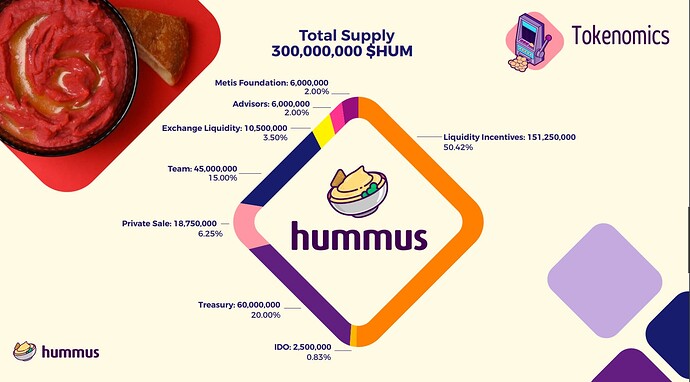Hummus.exchange is in Beta mode v1. Hummus.exchange is forked and operating under fair and non production usage in accordance with the relevant licenses.
Hummus is a stableswap protocol built on the METIS blockchain.
Our goal is to offer simple, creamy stableswaps (USDT, USDC, DAI) with deep liquidity to the METIS community, allowing them the ability to capitalize on stable-based opportunities in a timely and cost effective manner.
Hummus Features
![]() Officially Licensed Platypus Finance Fork
Officially Licensed Platypus Finance Fork
![]() Single Sided Staking
Single Sided Staking
![]() Gamified Staking Boost through veHUM
Gamified Staking Boost through veHUM
![]() Flexibile Liquidity Pool
Flexibile Liquidity Pool
![]() Low Liquidity Fragmentation
Low Liquidity Fragmentation
![]() Governance
Governance
Relevant Links
![]() Hummus Website
Hummus Website
![]() Hummus Roadmap
Hummus Roadmap
![]() Hummus Telegram
Hummus Telegram
![]() Hummus Twitter
Hummus Twitter
Hummus for Stakers
- Stake USDT/USDC/DAI without the risk of impermenant loss
- Earn HUM tokens and trading fees as staking reward
- Ability to stake HUM to receive veHUM
- Stake veHUM to enjoy a BOOST in staking rewards
- Withdraw the exact same number of tokens initially deposited (plus rewards)
- Participate in Hummus governance with veHUM
Hummus for Traders
- Swap to and from USDT/USDC/DAI with minimum slippage
- Capital Efficiency
- Easy scalability of liquidity pools with new tokens
Security
Hummus` Smart Contracts have been audited by both Hacken and Omniscia by way of being the first official Platypus Finance fork. Further audits to be conducted on future code.
The Tokens of Hummus
- HUM - the native token to Hummus Exchange.
- veHUM - HUM can be staked to generate veHUM. veHUM is neither transferable nor tradable due to the design of the smart contract, i.e. they are locked in the private wallet of the user.’
Single Sided Staking
Hummus offers single sided staking which removes the risk of impermenant loss to the staker. It is common in liquidity provision to be required to pair two assets together. As the value of one asset, the other, or both, fluctuates, the liquidity value of the staker adjusts to maintain a balance. This creates the risk of impermenant loss, where one or both assets fluctuate significantly, leaving the staker with substantially less or one asset and substantially more of another. The impermenant part of the loss comes with the theory that if the staker were to hold the depressed asset for long enough and it’s price recovers, the loss is erased. Instead of pools of token pairs and bundles, Hummus Exchange uses accounts of tokens to record assets and liabilities, allowing single-sided liquidity provision, removing the risk of impermenant loss completely.
HUM and the veHUM Advantage
When a staker deposits and stakes their stablecoin, they will begin to recieve HUM rewards as well as a percentage of trading fees. These HUM tokens can be traded on the open market or staked to earn veHUM. veHUM can be claimed and held in the staker’s wallet. Once claimed, the veHUM will provide a boost to the APY of the staker’s stablecoin deposit. When the user unstakes their HUM, all accumulated veHUM will be forfiet. In the future, veHUM will also act as a governance token.
In Summary
Hummus Exchange incentivizes users to stake their stablecoins into the protocol, with no risk of impermenant loss, creating deep stablecoin liquidity. The gamification of veHUM encourages the long-term staking of stablecoins within the protocol, minimizing volatility in liquidity. This liquidity is then enjoyed by the METIS ecosystem at large as a delicious and easy avenue for moving between stablecoins while preserving capital.
Hummus Exchange is the Next Gen Decentralized AMM for Stableswaps. Try us out today, on METIS

